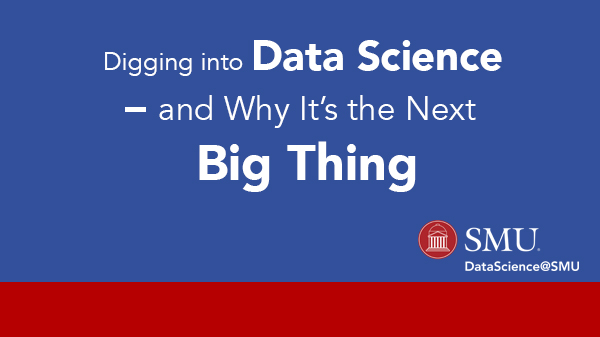Digging into Data Science – and Why It’s the Next Big Thing

It’s the best job this year. Scoring number one in Glassdoor’s recent rankings of best jobs in America for 2016, data scientist made the top of the list based on a composite score of median reported salary, job openings and career opportunities. Since it’s a relatively new field, many aren’t familiar with what data science actually is, so here we’ll dig into the details behind the term — as well as why it’s considered to be the next big thing.
The What
As digital devices and technologies continue to explode — so does the massive amount of data that results. The question facing every company today is not only about how to tap into that data — but how to make the most of it to achieve business goals.
Enter data science. Using data effectively requires a holistic approach — which is what differentiates data science when it comes to analysis. Data scientists gather data from “the wild,” massage it into a useable format, make it tell its story — and then present that story in a way that others can understand — notably, organizational leaders who need that information to guide business decisions.
Data scientists are unique in that they have a strong business acumen that supports this process. They don’t just analyze data to solve business problems — they know which problems to pick — and search for hidden gems in the data that can provide new insights to support a competitive business edge. As Anjul Bhambhri, vice president of big data products at IBM, noted, “A data scientist is somebody who is inquisitive, who can stare at data and spot trends. It’s almost like a Renaissance individual who really wants to learn and bring change to an organization.”
Such dynamics explain why the job growth for data science was strong in 2015, and why it tops Glassdoor’s list this year. According to the report, the median salary for a data scientist is $116,000 and there are over 1,700 job openings. McKinsey & Company says that by 2018 there will be a severe shortage of data scientists in the U.S. — estimated to be 140,000 to 180,000 less than what will be needed.
The Who
Data science is practiced by individuals who have the skills and training to access, analyze and present data, as previously described. There is a tremendous need for such individuals across many industries — from retail to government to biotech. This interesting list provides great insight into the role of data scientists in a variety of industries, including:
- Biotech
- Education
- Energy
- Finance
- Gaming and hospitality
- Government
- Health care
- Insurance
- Internet
- Manufacturing
- Pharmaceutical
- Retail
- Telecom
- Travel and transportation
- Utilities
Within such roles, they may hold a variety of titles — and may not be easy to spot specifically in “data scientist” terms. To better identify them, analysts of the industry — such as Burtchworks — use various metrics, including educational background, skills, dataset size, and job responsibilities. Such responsibilities typically include data acquisition, data cleaning/transformation, analytics, prescribing actions and programming/automation. With such unique skillsets required, becoming a data scientist usually entails obtaining an advanced education, such as a master’s degree in data science.
The Why
As The New York Times noted, data science “promises to revolutionize industries from business to government, health care to academia.” As the mountains of data continue to build, organizations are increasingly desperate to find the individuals who have the unique expertise to find the meaning within to help drive effective business decisions. It’s estimated that by 2018, 4 million to 5 million jobs in the United States will require data analysis skills, and “a shortage of the analytical and managerial talent necessary to make the most of big data is a significant and pressing challenge (for the U.S.).”
There is a looming void on the big data horizon for business, and it’s one that only data scientists will be able to fill. This factor — coupled with an attractive salary and the ability to pick from a variety of industries and locations — makes data science the next big thing for the individuals interested in this exciting field, as well as the companies who need them.
The How
If you’re ready to pursue a career in the number one job for 2016, consider earning an advanced degree in data science to help you do it. The Master of Science in Data Science degree from DataScience@SMU typically takes between 18 to 24 months to complete, and the curriculum merges computer science, statistics and data visualization, which incorporates 2-D and 3-D computer graphics. Students also receive hands-on training to learn how to retrieve, analyze and interpret data, and they learn how to clearly and effectively communicate their findings. Legal and ethical issues surrounding data, such as security and privacy, are also covered in the program, providing students with a well-rounded education that prepares them for an exciting career in this number one field of the year.
Learn more about DataScience@SMU
Last updated February 2016


